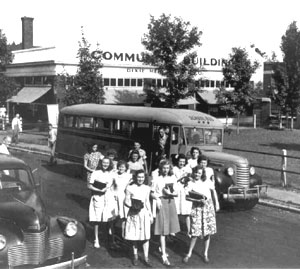
Dixie Spinning Mills
At the turn of the century, Chattanooga emerged as a textile manufacturing center, particularly for cotton hosiery. The 1913 introduction of the process of mercerizing, which gives yarn a fine silk finish, enhanced local industry and generated a new corporation, Dixie Mercerizing Company, controlled by local capitalist John T. Lupton. In 1922 this company’s success led to the establishment of Dixie Spinning Mills to supply yarn. Situated on one thousand acres north of the Tennessee River at a company town known as “Lupton City” outside of Chattanooga, the spinning mill began production in 1923 with twelve thousand spindles; within two years, thirty thousand spindles were in operation.
In order to secure and maintain a sufficient labor force, Dixie Spinning Mills built housing for its workers near the factory, a common practice among many New South textile firms. By 1929 Lupton City’s first sixty houses had grown to two hundred. For one dollar per room per week, employees received houses equipped with such modern conveniences as electricity and indoor plumbing. The village had concrete sidewalks, a school, a post office, a church, and a general store. As the number of employees grew, the company eventually added recreational facilities, including a gym, a movie theater, and a swimming pool. A company doctor and dentist also provided services to the workers.
Dixie Mills drew its work force from the surrounding farms, and many farmers abandoned the vicissitudes of agriculture for steady factory wages of ten to fourteen dollars a week. The work week was five and a half days long, at 12.5 hours per day for men and 10.5 hours per day for women. Financially strapped workers obtained credit from the company in the form of credit scrips, or tokens, redeemable at the company store. Workers’ lives revolved around the mills, which not only paid their wages, but controlled housing, material needs, and social activities within the “model” mill village of Lupton City.
With the increasing availability of reliable transportation after World War II, workers took advantage of opportunities to live and shop elsewhere. In the 1950s Dixie closed the company store and sold all but two of its mill houses, with workers receiving first option for purchase. At the time of the sale, less than 50 percent of Dixie workers lived in Lupton City housing. Dixie Yarns still operated its Lupton City plant during the mid-1990s, and many retirees reside in the previously company-owned houses of Lupton City. Together, the mill and the village incorporate economic and social developments characteristic of the industrial transformation of Chattanooga and Hamilton County.
Suggested Reading
Marirose Arendale, “Lupton City: Chattanoogas Model Mill Village,” Tennessee Historical Quarterly 43 (1984): 68-78



